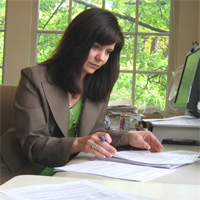Why Are My Students Performing So Poorly?

Synopsis:
Dr. Christina Delgado has been teaching for 15 years in mechanical engineering, but in one class she’s frustrated that her students’ performance is not meeting her expectations. Exam scores are lower than previous years she’s taught this class. Trying to figure out why her students are struggling, Christina speaks with an instructional consultant to tease out the roadblocks to student performance.
Dr. Christina Delgado has been teaching for 15 years in mechanical engineering, but in one class she’s frustrated that her students’ performance is not meeting her expectations. Exam scores are lower than previous years she’s taught this class. Trying to figure out why her students are struggling, Christina speaks with an instructional consultant to tease out the roadblocks to student performance.
Full Story:
Dr. Delgado is teaching Vibration Analysis, a senior level mechanical engineering class. She taught this class before. In fact, she taught it for 8 years but hasn’t taught it in the last 3 years. She looked forward to teaching this course again and had a refreshed outlook toward this class since she attended two teaching workshops and has taught mostly graduate students lately.
Dr. Delgado is teaching Vibration Analysis, a senior level mechanical engineering class. She taught this class before. In fact, she taught it for 8 years but hasn’t taught it in the last 3 years. She looked forward to teaching this course again and had a refreshed outlook toward this class since she attended two teaching workshops and has taught mostly graduate students lately.
Strategies Menu
The students have just completed their mid-term exam, but Christina is disappointed: the average score was 63%, and the low score was 35%. She expected an average score in the 80s.
Christina is very surprised with these numbers and can’t figure out why so many of her students performed poorly. She can imagine many possible explanations but is a bit muddled trying to think through them all. Since she’d like some support working through this mid-term problem and to ensure her students are learning, she met with an instructional consultant.
In the first part of the meeting, the instructional consultant asked Christina what signs of learning problems the students showed before this point. Christina recounted that she heard some squawking about some difficult homework problems and she noted average scores on two earlier quizzes were low.
The instructional consultant also asked about the mid-term exam and the kinds of questions students faced. Christina explained that she rewrote the exam to include questions that require higher-order thinking.
Considering the many factors that could impact poor student performance, the instructional consultant also inquired about the students’ knowledge going into this class, the energy level, the diversity of the students, and other qualities. Christina explained that her students are nearly all mechanical engineering majors with the usual mix of ages and ethnicities. But Christina brought up that, due to recent curricular changes, some mechanical engineering classes, including this vibrations analysis class, reduced from four credit hours to three.
The instructional consultant pointed out a few factors that could be affecting this class: Christina’s teaching style and expectations of students may have changed as a result of participating in teaching workshops and teaching graduate students for 3 years; these students may be less prepared for this course than the undergraduates Christina previously taught; or since Christina revised the content and structure of the course, there may still be some bugs to work out.
The instructional consultant then offered some suggestions:
- To tease apart the possible reasons or to identify new reasons why your students are struggling, consider obtaining data about the nature of their struggles. For example, have an instructional consultant come into your next class session and gather student feedback (sometimes called an SGID, Small Group Instructional Diagnosis). Working from data could be the most efficient way to make changes, helping you choose which of the remaining suggestions to try first.
- So that you are not surprised again, take more opportunities to assess your students learning throughout the term. Ungraded classroom assessment techniques can be a quick way to discover the areas your students are struggling with, allowing you to modify your teaching to help them. Especially when curricular changes affect prerequisites, learn what your students’ prior experience is.
- Now that your exam questions engage higher-order thinking, revisit your teaching techniques to ensure you are promoting deeper thinking. If you are asking harder questions on exams or even quizzes, build enough interactivity or discussion into class for the students to practice answering those questions (e.g., synthesizing concepts, evaluating a system)
- Changing credits also means changing class hours. You may need to revise course content to fit the time allowed for the class.
Dr. Christina Delgado was encouraged that she could improve her students’ learning, feeling she has options to pursue.
